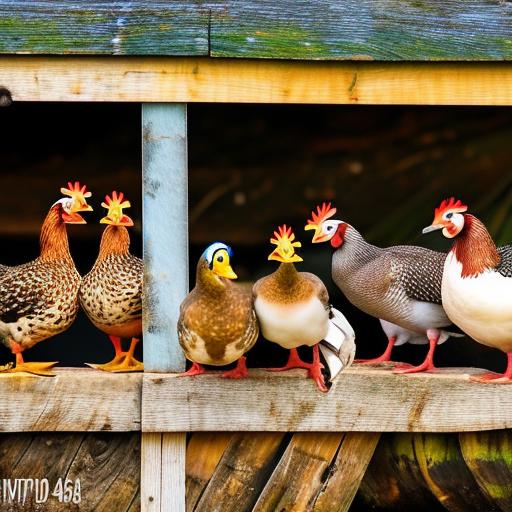Keeping chickens and ducks together in the same coop can be a rewarding and efficient way to raise poultry. Not only does it reduce space requirements, but it also allows for increased socialization between the two species. As someone who has personally kept chickens and ducks together, I can attest to the benefits of this arrangement. In this article, we will explore the advantages of keeping chickens and ducks in the same coop, factors to consider before doing so, understanding their social behavior, designing a coop that accommodates both species, feeding strategies, health and hygiene considerations, tips for managing them together, common challenges, and ultimately, whether keeping chickens and ducks in the same coop is right for you.
Key Takeaways
- Keeping chickens and ducks together can be a great way to maximize space and resources.
- Chickens and ducks have different needs and behaviors that must be considered before cohabiting.
- Understanding the social hierarchy of both species is crucial for a successful mixed coop.
- A well-designed coop with separate areas for nesting and feeding can help prevent conflicts.
- Proper hygiene and disease prevention measures are essential for the health of both chickens and ducks in a mixed coop.
Benefits of Keeping Chickens and Ducks in the Same Coop
One of the main benefits of keeping chickens and ducks together is reduced space requirements. By sharing a coop, you can save on building costs and utilize your available space more efficiently. Additionally, keeping them together allows for increased socialization between the two species. Chickens and ducks have different behaviors and characteristics, and by interacting with each other, they can learn from one another and develop a more diverse social dynamic.
Another advantage of keeping chickens and ducks together is mutual pest control. Chickens are known for their ability to eat insects and other pests, while ducks are excellent at controlling slugs and snails. By combining these two species in one coop, you can create a natural pest control system that benefits both birds.
Lastly, keeping chickens and ducks together allows for more efficient use of resources. For example, ducks produce a lot of water waste due to their aquatic nature. By having them share a coop with chickens, who require less water, you can minimize water waste and ensure that resources are used effectively.
Factors to Consider Before Keeping Chickens and Ducks Together
Before deciding to keep chickens and ducks together in the same coop, there are several factors to consider. First and foremost, you need to ensure that the breeds you choose are compatible. Some chicken breeds may be more aggressive towards ducks, while others may be more accepting. It is important to do your research and choose breeds that are known to coexist well.
Space requirements are another crucial factor to consider. Both chickens and ducks require adequate space to move around and engage in their natural behaviors. Make sure that your coop is large enough to accommodate both species comfortably.
Feeding and watering needs should also be taken into account. Chickens and ducks have different dietary requirements, so you will need to provide separate feeders and waterers for each species. Additionally, you should consider potential health risks associated with keeping chickens and ducks together. Ducks are more resistant to certain diseases than chickens, so it is important to take precautions to prevent the spread of any potential illnesses.
Understanding the Social Behavior of Chickens and Ducks
Chickens and ducks have different social behaviors, and understanding these differences is crucial when introducing new birds to the flock. Chickens are hierarchical animals, meaning they establish a pecking order within their group. This can lead to aggression towards new birds, especially if they are perceived as a threat to their established social structure.
Ducks, on the other hand, are more social and less hierarchical. They tend to form close bonds with their flock mates and are generally accepting of new members. However, it is still important to introduce new birds gradually and monitor their interactions to ensure a smooth integration.
When introducing new birds to the flock, it is recommended to do so during the daytime when they can see each other clearly. Provide plenty of space for the birds to move around and establish their own territories. It may take some time for them to adjust and establish a new pecking order, but with patience and monitoring, they should eventually settle into a harmonious coexistence.
Signs of aggression or stress to watch for include excessive pecking, feather plucking, and isolation from the rest of the flock. If you notice any of these signs, it may be necessary to separate the birds temporarily until they can be reintroduced in a more controlled manner.
Designing a Coop for Chickens and Ducks
When designing a coop for chickens and ducks, there are several considerations to keep in mind. First and foremost, the coop should be large enough to accommodate both species comfortably. Each bird should have enough space to move around, roost, and engage in their natural behaviors.
Nesting boxes and roosting areas should be provided for both chickens and ducks. Chickens prefer elevated roosting areas, while ducks prefer nesting boxes on the ground. By providing separate areas for each species, you can ensure that they have a comfortable and safe space to lay their eggs and rest.
Water and food stations should also be designed with both species in mind. Ducks require access to water for swimming and cleaning themselves, so a shallow pool or trough should be provided. Chickens, on the other hand, require access to feeders that are raised off the ground to prevent contamination.
Flooring and bedding options should be chosen carefully to accommodate both chickens and ducks. Ducks produce a lot of water waste, so the coop should have proper drainage to prevent flooding. Bedding materials such as straw or wood shavings should be used to provide a comfortable and clean environment for both species.
Feeding Chickens and Ducks in the Same Coop

Feeding chickens and ducks in the same coop can be challenging due to their different dietary needs. Chickens are omnivores and require a balanced diet of grains, protein, fruits, and vegetables. Ducks, on the other hand, are primarily herbivores and require a diet that is high in greens and low in protein.
To ensure that both species get proper nutrition, it is recommended to provide separate feeders for each. This allows you to control the amount and type of feed that each bird receives. Additionally, you can supplement their diets with kitchen scraps and forage to provide a more varied and natural diet.
It is important to monitor the feeding process to prevent overfeeding or underfeeding. Chickens are known to be voracious eaters and may consume all the food before the ducks have a chance to eat. To prevent this, you can provide separate feeding areas or use feeders that are designed to prevent spillage.
Health and Hygiene Considerations for Mixed Coops
When keeping chickens and ducks together in the same coop, it is important to take measures to prevent the spread of diseases. Ducks are generally more resistant to certain diseases than chickens, but they can still carry and transmit pathogens.
Regular cleaning and disinfecting of the coop is crucial to maintain a healthy environment for both species. Remove any droppings, soiled bedding, or uneaten food on a daily basis. Disinfect the coop periodically using a poultry-safe disinfectant to kill any potential pathogens.
Parasite control is also important when keeping chickens and ducks together. Both species are susceptible to external parasites such as mites and lice. Regularly inspect your birds for signs of infestation and take appropriate measures to treat and prevent parasites.
Tips for Managing Chickens and Ducks in the Same Coop
Managing chickens and ducks in the same coop requires regular monitoring and attention to their behavior and health. It is important to observe their interactions on a daily basis to ensure that they are getting along well. If any signs of aggression or stress are observed, it may be necessary to separate the birds temporarily until they can be reintroduced in a more controlled manner.
Providing adequate space and resources is crucial for maintaining a harmonious coexistence. Make sure that each bird has enough space to move around and engage in their natural behaviors. Provide separate feeding and watering stations to prevent competition and ensure that each species gets the nutrition they need.
If necessary, it may be beneficial to separate the birds temporarily to give them a break from each other. This can help reduce aggression and stress and allow them to establish their own territories. However, it is important to reintroduce them gradually and monitor their interactions to ensure a smooth reintegration.
Common Challenges of Keeping Chickens and Ducks Together
Keeping chickens and ducks together in the same coop can come with its own set of challenges. One common challenge is aggression between birds. Chickens can be territorial and may exhibit aggressive behavior towards ducks, especially if they feel threatened or if there is competition for resources. It is important to monitor their interactions closely and intervene if necessary to prevent injury.
Another challenge is messy coop conditions. Ducks produce a lot of water waste, which can lead to wet and unsanitary conditions in the coop. Regular cleaning and proper drainage are essential to maintain a clean and healthy environment for both species.
Health issues can also arise when keeping chickens and ducks together. Ducks are generally more resistant to certain diseases than chickens, but they can still carry and transmit pathogens. It is important to take measures to prevent the spread of diseases through regular cleaning, disinfecting, and parasite control.
Is Keeping Chickens and Ducks in the Same Coop Right for You?
Keeping chickens and ducks together in the same coop can be a rewarding and efficient way to raise poultry. The benefits include reduced space requirements, increased socialization, mutual pest control, and more efficient use of resources. However, there are several factors to consider before making this decision, including breed compatibility, space requirements, feeding needs, and potential health risks.
Understanding the social behavior of chickens and ducks is crucial when introducing new birds to the flock. Providing a well-designed coop that accommodates both species is essential for their comfort and well-being. Feeding strategies should be implemented to ensure that both chickens and ducks get proper nutrition without overfeeding or underfeeding.
Health and hygiene considerations are important to prevent the spread of diseases and maintain a clean environment. Regular monitoring and management of behavior and health are necessary to ensure a harmonious coexistence. Despite the challenges that may arise, keeping chickens and ducks together can be a rewarding experience if done properly and with careful consideration of individual circumstances.
If you’re wondering whether you can keep chickens and ducks in the same coop, you’ll find some valuable insights in this article from Poultry Wizard. They discuss the benefits and considerations of housing these two poultry species together, providing practical tips and advice for successful cohabitation. To learn more about creating a harmonious living environment for your feathered friends, check out their informative article on Poultry Wizard.
FAQs
What are the benefits of keeping chickens and ducks together in the same coop?
Keeping chickens and ducks together in the same coop can provide several benefits, such as reducing the amount of space needed for separate coops, saving money on feed costs, and providing companionship for the birds.
What are the potential problems of keeping chickens and ducks together in the same coop?
There are several potential problems that can arise when keeping chickens and ducks together in the same coop, such as differences in dietary needs, aggression between the birds, and the risk of disease transmission.
What should be considered when designing a coop for both chickens and ducks?
When designing a coop for both chickens and ducks, it is important to consider the size of the coop, the type of bedding used, the placement of food and water sources, and the need for separate nesting boxes.
Can chickens and ducks share the same food and water sources?
Chickens and ducks have different dietary needs, so it is important to provide separate food and water sources for each species. Chickens require a higher protein diet, while ducks require more niacin and calcium.
What are some tips for keeping chickens and ducks together in the same coop?
Some tips for keeping chickens and ducks together in the same coop include providing plenty of space, providing separate food and water sources, monitoring the birds for signs of aggression or illness, and providing separate nesting boxes.
Meet Walter, the feathered-friend fanatic of Florida! Nestled in the sunshine state, Walter struts through life with his feathered companions, clucking his way to happiness. With a coop that’s fancier than a five-star hotel, he’s the Don Juan of the chicken world. When he’s not teaching his hens to do the cha-cha, you’ll find him in a heated debate with his prized rooster, Sir Clucks-a-Lot. Walter’s poultry passion is no yolk; he’s the sunny-side-up guy you never knew you needed in your flock of friends!







